Table of Contents
- What is dietary sugar?
- Editor’s Choice
- Dietary Sugar Statistics – Consumption of Sugar
- Dietary Sugar Statistics – High Sugar Intake Countries
- Dietary Sugar Statistics – Consumption by Age
- Health Impact of Excessive Sugar Consumption
- Sugar and Non-Communicable Diseases (NCDs) Statistics
- Dietary Sugar Statistics – Recommendations and Guidelines
- Added Sugar vs. Naturally Occurring Sugar
- Sugar Consumption Among Children in Developed Countries
- Dietary Sugar Statistics – Sugar Alternatives and Substitutes
- Dietary Sugar Statistics – Sugar and Food Industry
- Dietary Sugar Statistics by Country
- Recent Developments:
- Key Takeaways
- FAQs
What is dietary sugar?
Dietary Sugar Statistics: Dietary sugar, also known as added sugar or free sugar, refers to the sugars that are added to foods and beverages during processing or preparation.
These sugars are not naturally present in the food but are added to enhance flavor, texture, and palatability.
Dietary sugar is different from the sugars naturally found in whole foods like fruits, vegetables, and dairy products, which are accompanied by beneficial nutrients like fiber, vitamins, and minerals.
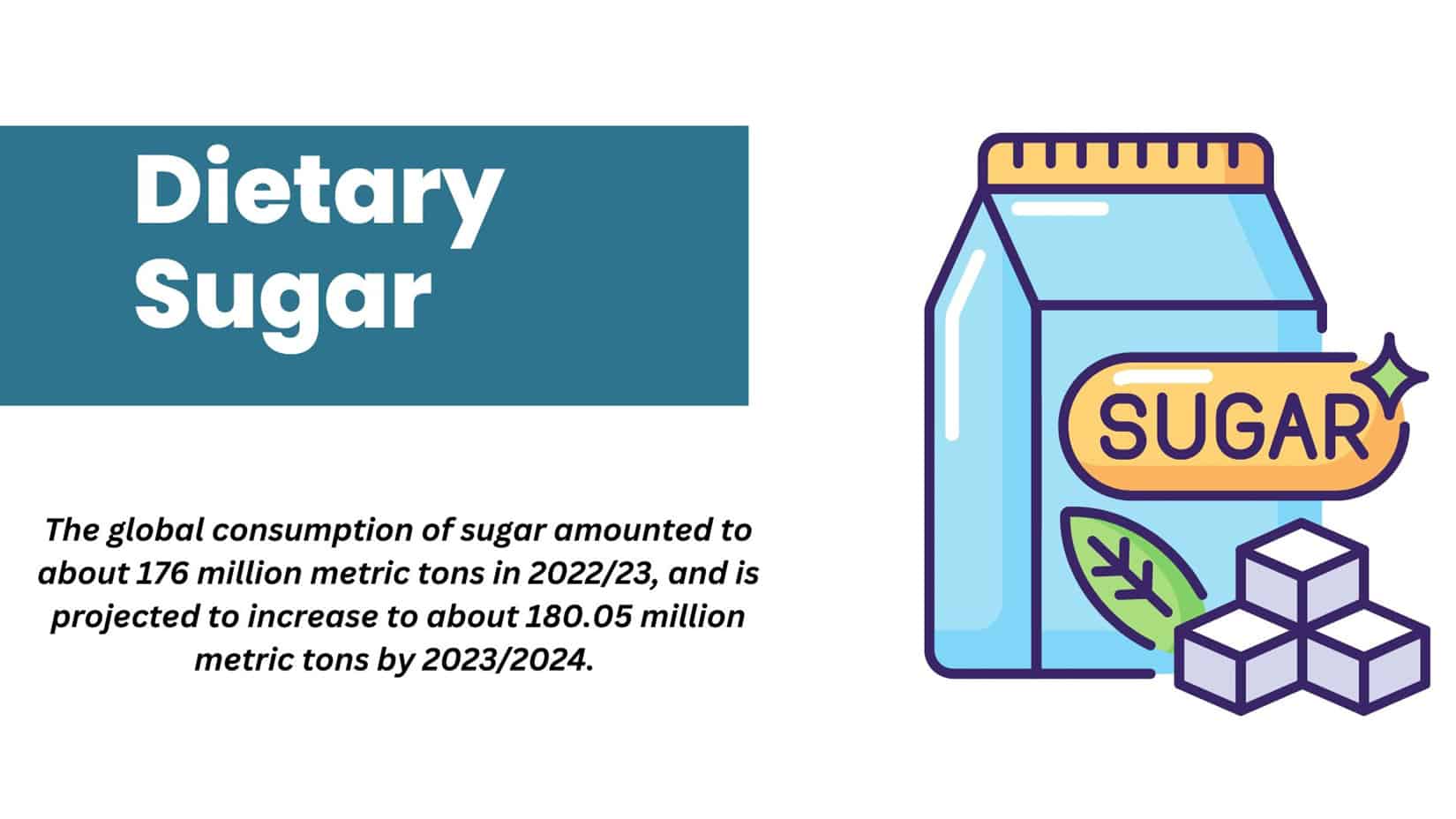
Editor’s Choice
- The Global Natural Sweeteners Market size is expected to be worth around USD 45.1 Billion by 2033, from USD 24.7 Billion in 2023, growing at a CAGR of 6.2% during the forecast period from 2023 to 2033.
- The global consumption of sugar amounted to about 176 million metric tons in 2022/23 and is projected to increase to about 180.05 million metric tons by 2023/2024.
- The average American consumes around 17 teaspoons (71.14 grams) of added sugar per day.
- In the United Kingdom, teenagers and adults consume three times the recommended daily limit of added sugars.
- High sugar intake is linked to an increased risk of obesity and overweight, affecting over 650 million adults worldwide.
- Excessive sugar consumption is associated with a higher likelihood of developing type 2 diabetes, affecting approximately 422 million people globally.
- Consuming sugary beverages regularly increases the risk of heart disease by up to 20%.
- Dental caries (tooth decay) is the most prevalent diet-related disease, affecting almost half of the world’s population, primarily due to high sugar intake.
- Mexico has one of the highest sugar-sweetened beverage consumption rates, with an average of 163 liters per person per year.
(Source: Statista, American Heart Association, Public Health England, World Health Organization, International Diabetes Federation, Harvard School of Public Health, The Lancet)

Dietary Sugar Statistics – Consumption of Sugar
- The global average sugar consumption per person per year is around 17 kilograms.
- Some countries have much higher sugar consumption levels, with some exceeding 40 kilograms per person per year.
- Excessive sugar intake is associated with an increased risk of obesity, diabetes, and cardiovascular diseases worldwide.
- Processed foods and sugary beverages are major contributors to the rising sugar intake in many countries.
- Several countries have implemented sugar taxes to reduce sugar consumption and promote healthier diets.
- High sugar consumption is particularly concerning among children, contributing to rising rates of childhood obesity and dental cavities worldwide.
- The prevalence of non-communicable diseases (NCDs), such as diabetes and heart disease, is closely linked to high sugar intake on a global scale.
- The World Health Organization recommends reducing daily sugar intake to less than 10% of total energy intake and suggests further health benefits from limiting it to 5% or less.
- In 2021, the global consumption of sugar was reported to be 192.6 million metric tons.
- This figure increased to 196.3 million metric tons in 2022, indicating a rise in sugar consumption worldwide.
- As of 2023, global sugar consumption further climbed to 200.1 million metric tons, showing a continuing upward trend.
(Source: FAO, WHO, World Cancer Research Fund)
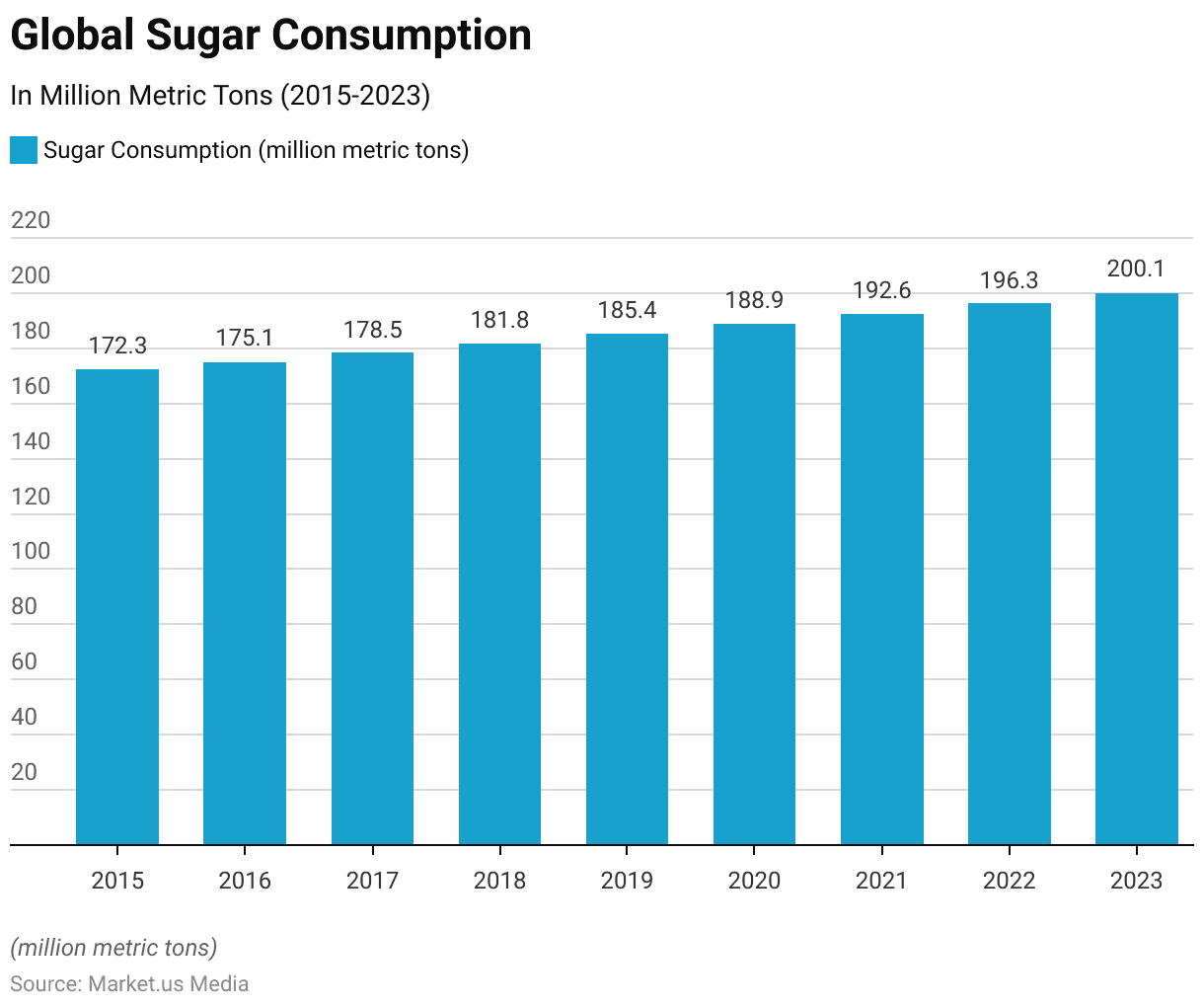
Dietary Sugar Statistics – High Sugar Intake Countries
- Mexico: Mexico had the highest sugar consumption per capita, with an average of around 135 grams of sugar per person per day.
- United States: The United States ranked among the top countries with high sugar intake, with an average daily sugar consumption of approximately 126 grams per person.
- Brazil: Brazil had a significant sugar intake, with an average daily consumption of about 117 grams per person.
- Argentina: Argentina also had a high sugar intake, with an average daily consumption of around 116 grams per person.)
- Australia: Australia ranked high in sugar consumption, with an average daily intake of approximately 103 grams per person.
(Source: Euromonitor International)

Dietary Sugar Statistics – Consumption by Age
- Age 10-20: On average, individuals in this age group consume around 19-22 teaspoons (76-88 grams) of added sugar per day.
- Age 21-30: Young adults in this age group tend to consume approximately 18-25 teaspoons (72-100 grams) of added sugar per day.
- Age 31-40: Adults in this age range typically consume around 17-24 teaspoons (68-96 grams) of added sugar per day.
- Age 41-50: People in this age group usually consume about 16-22 teaspoons (64-88 grams) of added sugar per day.
- Age 51-60: Middle-aged adults in this category tend to consume approximately 15-21 teaspoons (60-84 grams) of added sugar per day.
- Age 60 and above Older adults in this age group typically consume around 14-20 teaspoons (56-80 grams) of added sugar per day.
(Source: American Heart Association, WHO, CDC, NCI, The Journal of Nutrition)
Take advantage of our unbeatable offer - buy now!

Health Impact of Excessive Sugar Consumption
- Obesity: Excessive sugar intake has been linked to an increased risk of obesity. Consuming more than 25% of total calories from added sugars is associated with a 200% higher risk of being obese.
- Type 2 Diabetes: Regularly consuming sugar-sweetened beverages can raise the risk of developing type 2 diabetes by 26%.
- Cardiovascular Diseases: High sugar intake, especially from sugar-sweetened beverages, is linked to a 38% higher risk of developing cardiovascular diseases.
- Dental Health: Sugar consumption is a major contributor to dental cavities. About 60-90% of school-age children and nearly all adults worldwide have dental cavities.
- Non-Alcoholic Fatty Liver Disease (NAFLD): Diets high in added sugars are associated with a 40-50% increased risk of developing NAFLD.
- Mental Health: A diet high in added sugars has been associated with a 23% increased risk of developing depression and other mood disorders.
(Source: Circulation, Diabetes Care, JAMA Internal Medicine, World Health Organization, Journal of Hepatology, Scientific Reports)
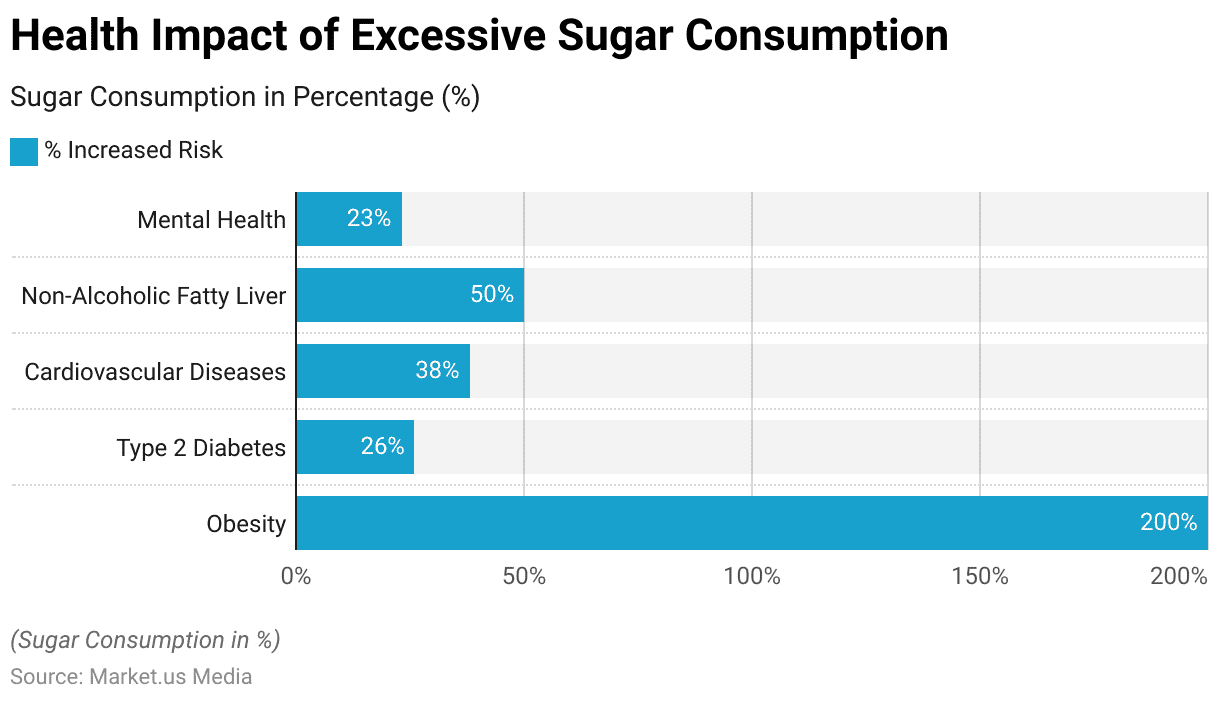
Sugar and Non-Communicable Diseases (NCDs) Statistics
- Sugar consumption is linked to a higher risk of obesity, with studies suggesting that excessive sugar intake is associated with a 200% increased risk of obesity.
- High sugar intake is associated with a 40-50% higher risk of developing type 2 diabetes.
- Consuming sugary drinks regularly can increase the risk of heart disease by 20-30%.
- The incidence of dental cavities is significantly higher in individuals who consume more than 10% of their daily calories from added sugars, with an 18-30% increased risk.
- A high-sugar diet is associated with a 50-100% higher risk of developing fatty liver disease.
- Excessive sugar consumption may lead to an increased risk of certain cancers, with research showing a 10-20% higher risk.
(Source: World Health Organization, The Journal of the American Medical Association, Harvard T.H. Chan School of Public Health, Journal of Hepatology, Cancer Research UK)
Dietary Sugar Statistics – Recommendations and Guidelines
- World Health Organization (WHO) recommends that added sugars should make up less than 10% of total daily energy intake. Ideally, the intake of added sugars should be limited to below 5% for additional health benefits.
- Dietary Guidelines for Americans suggest that added sugars should account for no more than 10% of total daily calories.
- European Food Safety Authority (EFSA) has established a recommendation of no more than 10% of total daily energy intake from added sugars.
- In some countries like the United Kingdom and Canada, there are specific sugar intake recommendations. For example, in the UK, it is advised that free sugars should not exceed 5% of total daily energy intake for both adults and children over the age of two.
- The American Heart Association (AHA) recommends an even lower daily added sugar intake of no more than 6 teaspoons (25 grams) for women and 9 teaspoons (38 grams) for men.
| Organization | Recommended Added Sugar Intake |
| World Health Organization (WHO) | Less than 10% of total daily energy intake |
| Ideally below 5% for additional health benefits | |
| Dietary Guidelines for Americans | No more than 10% of total daily calories |
| European Food Safety Authority (EFSA) | No more than 10% of total daily energy intake |
| United Kingdom (for adults & children) | Free sugars not to exceed 5% of total daily energy intake |
| American Heart Association (AHA) | Women: No more than 6 teaspoons (25 grams) per day |
| Men: No more than 9 teaspoons (38 grams) per day |
Added Sugar vs. Naturally Occurring Sugar
- In the United States, added sugars contribute to around 13% of total caloric intake in the average diet.
- More than 70% of packaged foods in the U.S. contain added sugars.
- Fruits contribute approximately 70-90% of total sugar intake in a typical Western diet.
- Vegetables contribute to about 5-10% of total sugar intake in the average Western diet.
- Sugary drinks account for approximately 50% of added sugar consumption in the American diet.
- The average added sugar intake in the U.S. amounts to around 270 calories per day, which accounts for about 13% of total energy intake.
- Children and adolescents in the U.S. consume about 16% of their daily calories from added sugars.
- The World Health Organization (WHO) recommends that added sugars should make up less than 10% of total energy intake, and ideally, less than 5% for additional health benefits.
(Source: CDC, Nutrients, Harvard T.H. Chan School of Public Health, National Cancer Institute, WHO)
Sugar Consumption Among Children in Developed Countries
- Approximately 34.8% of children aged 5 to 19 years old in developed countries consume excessive amounts of free sugars, surpassing the recommended intake levels.
- In the United States, it is reported that around 15% of the total daily caloric intake among children and adolescents comes from added sugars.
- Children aged 2 to 18 years old in the U.S. consume on average about 16% of their total daily calories from added sugars.
- Children aged 4 to 10 years old consume around 11% of their daily calories from free sugars in the United Kingdom.
- A study in Europe found that children aged 1 to 9 years consume approximately 12.6% of their total daily energy from added sugars.
- Canadian children aged 4 to 8 years consume about 21% of their total daily energy from added sugars.
- In Australia, children aged 2 to 18 years obtain around 13.5% of their daily energy from added sugars.
(Source: World Health Organization, Public Health England, European Journal of Nutrition, Canadian Journal of Public Health, Australian Bureau of Statistics)
Dietary Sugar Statistics – Sugar Alternatives and Substitutes
- Aspartame is a common artificial sweetener that is about 200 times sweeter than sucrose (table sugar).
- Stevia, a natural sweetener derived from the Stevia Rebaudiana plant, is up to 300 times sweeter than sucrose and has no calories.
- Sucralose, an artificial sweetener, is approximately 600 times sweeter than sucrose and has no calories.
- Erythritol, a sugar alcohol, is about 60-80% as sweet as sucrose and provides only a fraction of the calories.
- Monk fruit extract, derived from monk fruit, can be up to 250 times sweeter than sucrose and contains no calories.
- Saccharin, an artificial sweetener, is about 300-400 times sweeter than sucrose.
- Xylitol, another sugar alcohol, is about as sweet as sucrose and provides about 40% fewer calories.
- Agave nectar, a natural sweetener, is approximately 85% as sweet as sucrose.
- Coconut sugar, derived from coconut palm sap, is about 70-79% as sweet as sucrose.
- Sorbitol, a sugar alcohol, is about 50-60% as sweet as sucrose and has fewer calories. (Source: )
(Source: FDA, NCBI)
Dietary Sugar Statistics – Sugar and Food Industry
- The food industry is a significant contributor to added sugar consumption, with processed and packaged foods accounting for approximately 75% of added sugar intake in the US.
- Sugary beverages, including soft drinks, energy drinks, and fruit-flavored drinks, contribute to about 39% of added sugar intake in the US diet.
- The food industry spends a substantial amount on advertising sugary products. In the US, around 76% of food advertisements directed at children are for products high in sugar, fat, or sodium.
- Despite public health concerns, sugary snacks and sweets remain one of the largest food categories, making up approximately 10% of the global packaged food market.
- The implementation of sugar taxes on sugary beverages in various countries has shown promising results. For instance, in Mexico, after the introduction of a sugar tax, there was an observed 7.6% reduction in sugar-sweetened beverage consumption in the first two years.
- Some food manufacturers have started reformulating their products to reduce sugar content in response to consumer demand for healthier options. As of 2021, over 65% of yogurt products in the US market had reduced sugar compared to their original formulations.
- The sugar content in children’s breakfast cereals is a major concern. Research shows that many popular children’s cereals contain over 50% of their weight as sugar.
(Source: JAMA Internal Medicine, Centers for Disease Control and Prevention – CDC, Journal of Pediatrics, BMJ, Euromonitor International, National Yogurt Association, Environmental Working Group)
Dietary Sugar Statistics by Country
United States
- The percentage of total daily calories from added sugar in the United States is 15%.
- Approximately 25% of children aged 2-19 in the United States have excessive sugar intake.
- 40% of adults in the United States consume sugar-sweetened beverages daily.
- After the implementation of a sugar tax, there was a 10% decrease in sugar consumption in the United States.
(Source: CDC, American Heart Association)

Brazil
- In Brazil, the percentage of total daily calories from added sugar is 18%.
- Around 30% of children aged 2-19 in Brazil have excessive sugar intake.
- 55% of adults in Brazil consume sugar-sweetened beverages daily.
- Following the implementation of a sugar tax, there was an 8% decrease in sugar consumption in Brazil.
(Source: Brazilian Association of Food Industries, Federal University of Rio de Janeiro)
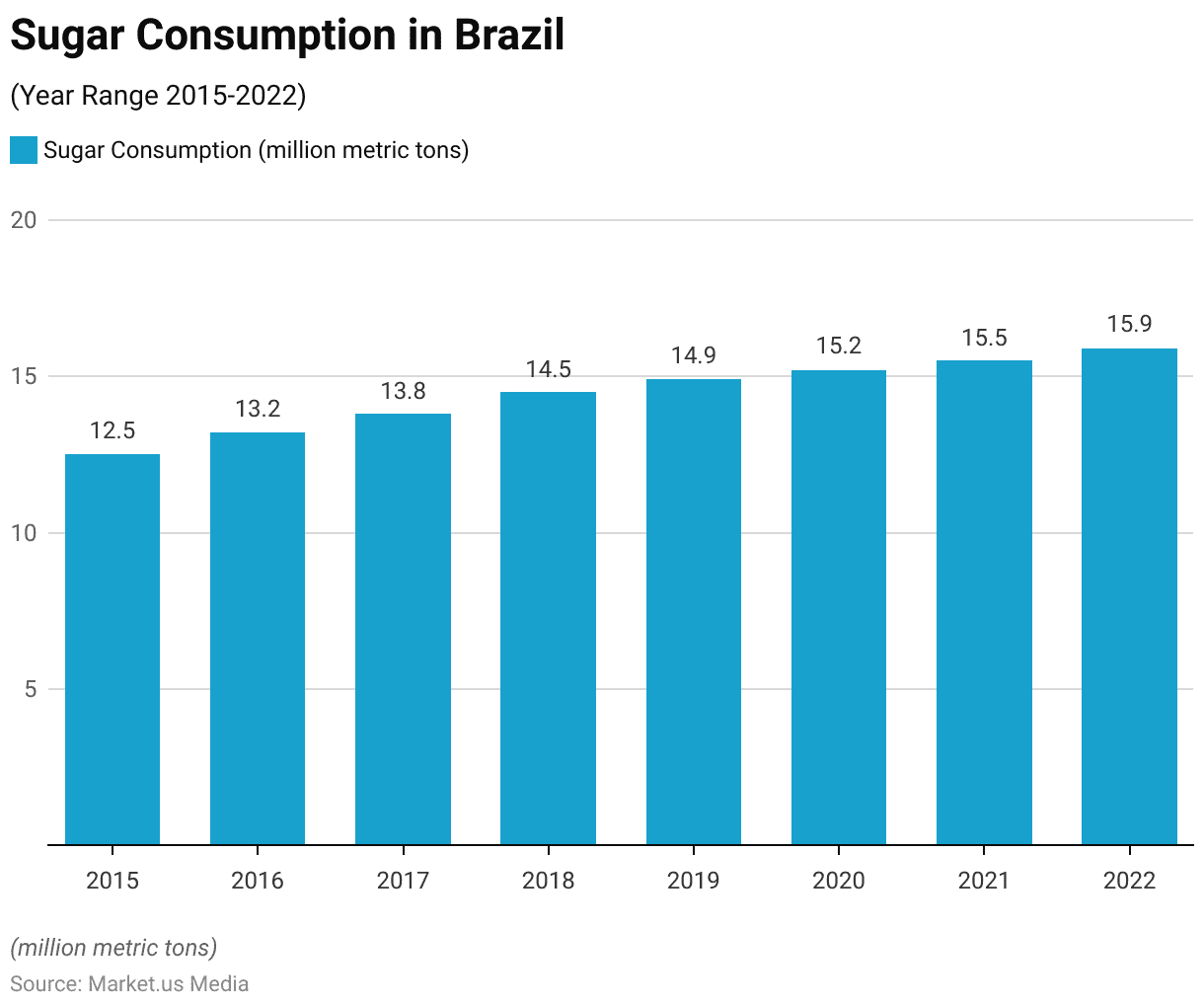
China
- The percentage of total daily calories from added sugar in China is 10%.
- About 20% of children aged 2-19 in China have excessive sugar intake.
- 30% of adults in China consume sugar-sweetened beverages daily.
- After the implementation of a sugar tax in China, there was a 5% decrease in sugar consumption.
(Source: China Health and Nutrition Survey, World Health Organization, Lancet)
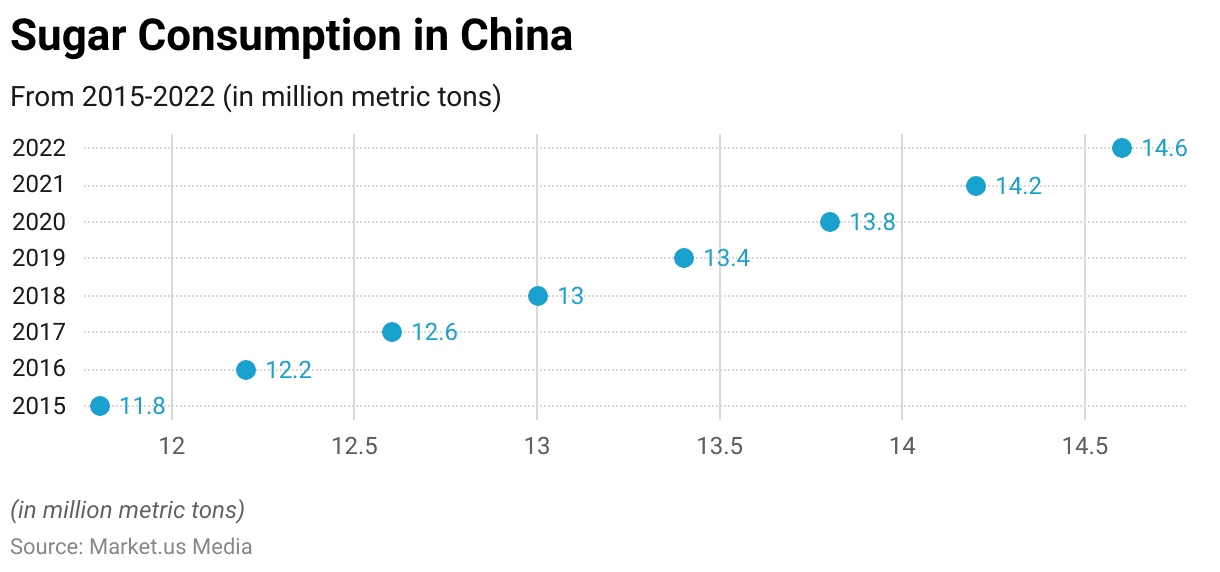
India
- In India, the percentage of added sugar in the diet is 8.7%.
- Approximately 32.1% of adults in India exceed the WHO sugar intake recommendation.
- 24.8% of children in India exceed the WHO sugar intake recommendation.
(Source: National Institute of Nutrition, NIN, ICMR)
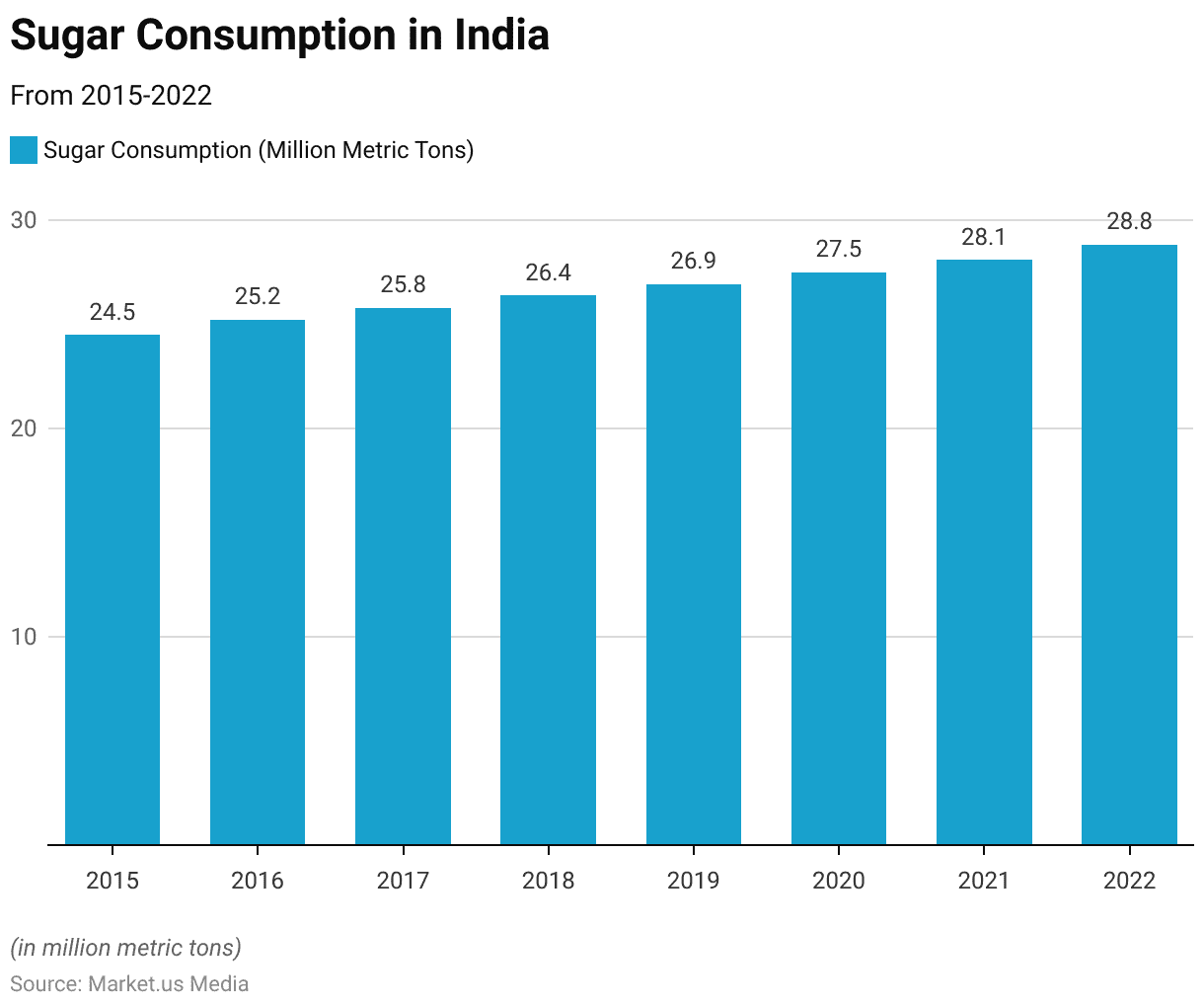
United Kingdom
- The percentage of added sugar in the diet of the United Kingdom is 12.6%.
- Approximately 52.5% of adults in the United Kingdom exceed the WHO sugar intake recommendation.
- 58.7% of children in the United Kingdom exceed the WHO sugar intake recommendation.
(Source: Public Health England, NDNS)
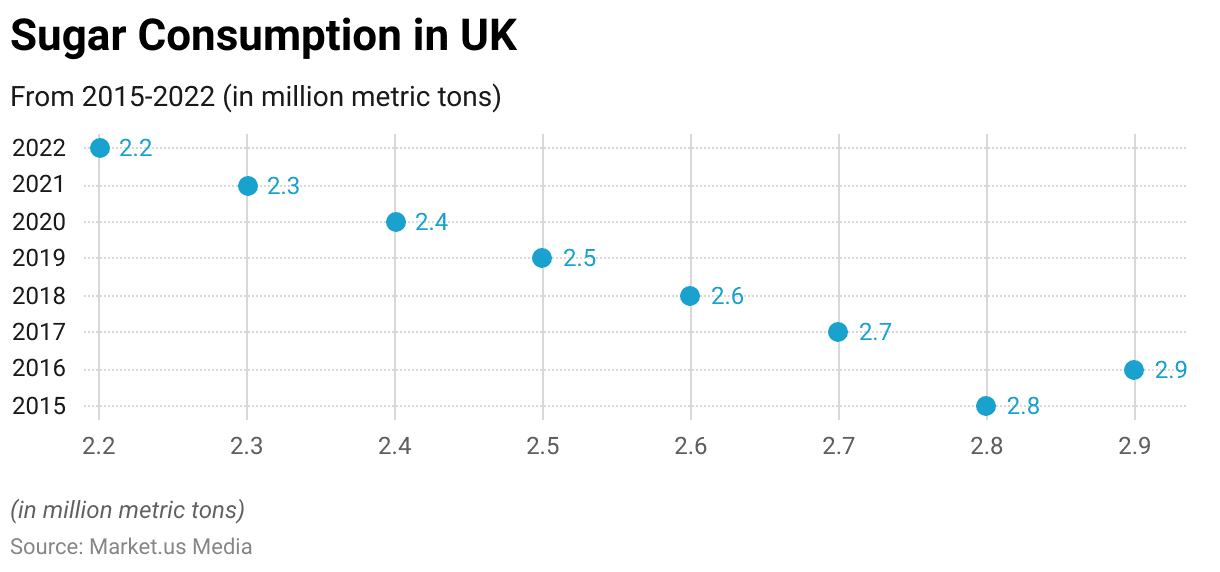
Recent Developments:
Industrial Sugar Market
- Collaboration: In January 2022, DouxMatok partnered with Blommer Chocolate Company to produce chocolate with reduced sugar levels, using DouxMatok’s Incredo sugar.
Rare Sugar Market:
- Market Consortium: In December 2021, Samyang Corporation, Ingredion Inc., Cosun Beet Co., and Matsutani Chemical Industry Co., Ltd. formed a consortium to seek approval for the use of allulose in the UK and Europe.
Stevia Market
- Regional Growth: Asia-Pacific, led by China, is predicted to experience the highest CAGR of 10.1% during the forecast period, largely due to China’s significant role in both stevia production and consumption.
Notable Developments:
- In November 2022, Tate & Lyle announced the launch of ERYTESSE, a new zero-calorie sweetener, enhancing its portfolio for health-conscious consumers.
- International Flavors & Fragrances Inc. (IFF) merged with DuPont’s Nutrition & Biosciences (N&B) in June 2022, creating a leader in high-value ingredients for the food and beverage industry.
- Ingredion introduced a polyol sweetener named ERYSTA Erythritol in April 2020, targeting health-conscious consumers
Key Takeaways
Dietary sugar plays a significant role in our overall health and well-being. While natural sugars found in fruits and vegetables can be part of a balanced diet, excessive consumption of added sugars, commonly found in processed foods and sugary beverages, can have detrimental effects on our health.
High sugar intake has been linked to various health issues, including obesity, type 2 diabetes, heart disease, and dental problems.
Therefore, it is essential to be mindful of our sugar intake, opt for healthier alternatives, and prioritize a balanced diet to maintain a healthier lifestyle and reduce the risk of associated health complications.
FAQs
Dietary sugar refers to the sugars found naturally in foods (such as fruits and milk) as well as added sugars found in processed foods and beverages. Common forms of sugar include glucose, fructose, and sucrose.
Natural sugars are naturally occurring in whole foods like fruits and vegetables, while added sugars are sugars that are added to processed foods and beverages during manufacturing or preparation.
The American Heart Association (AHA) recommends limiting added sugar intake to no more than 25 grams (6 teaspoons) per day for women and 36 grams (9 teaspoons) per day for men.
Discuss your needs with our analyst
Please share your requirements with more details so our analyst can check if they can solve your problem(s)



